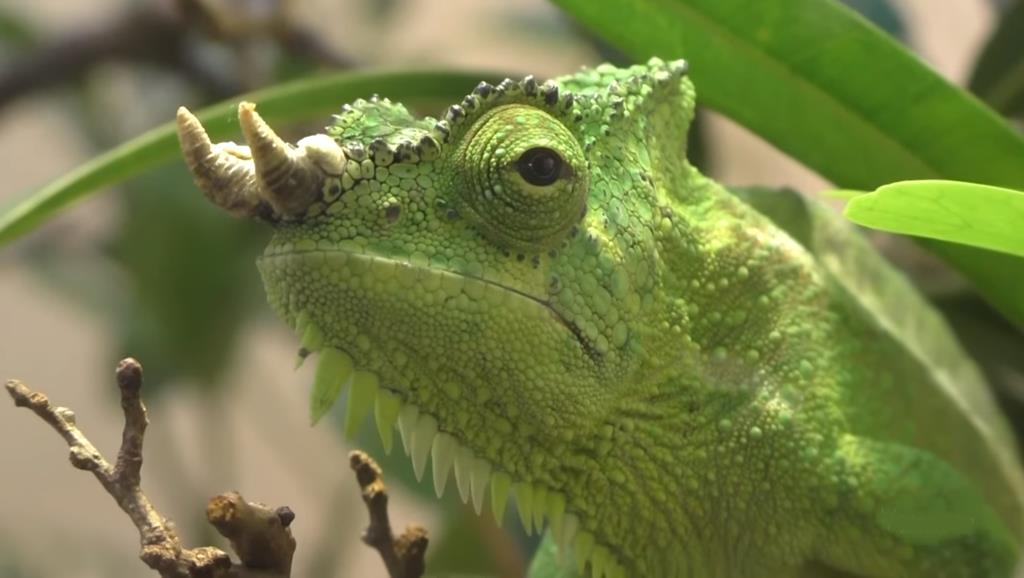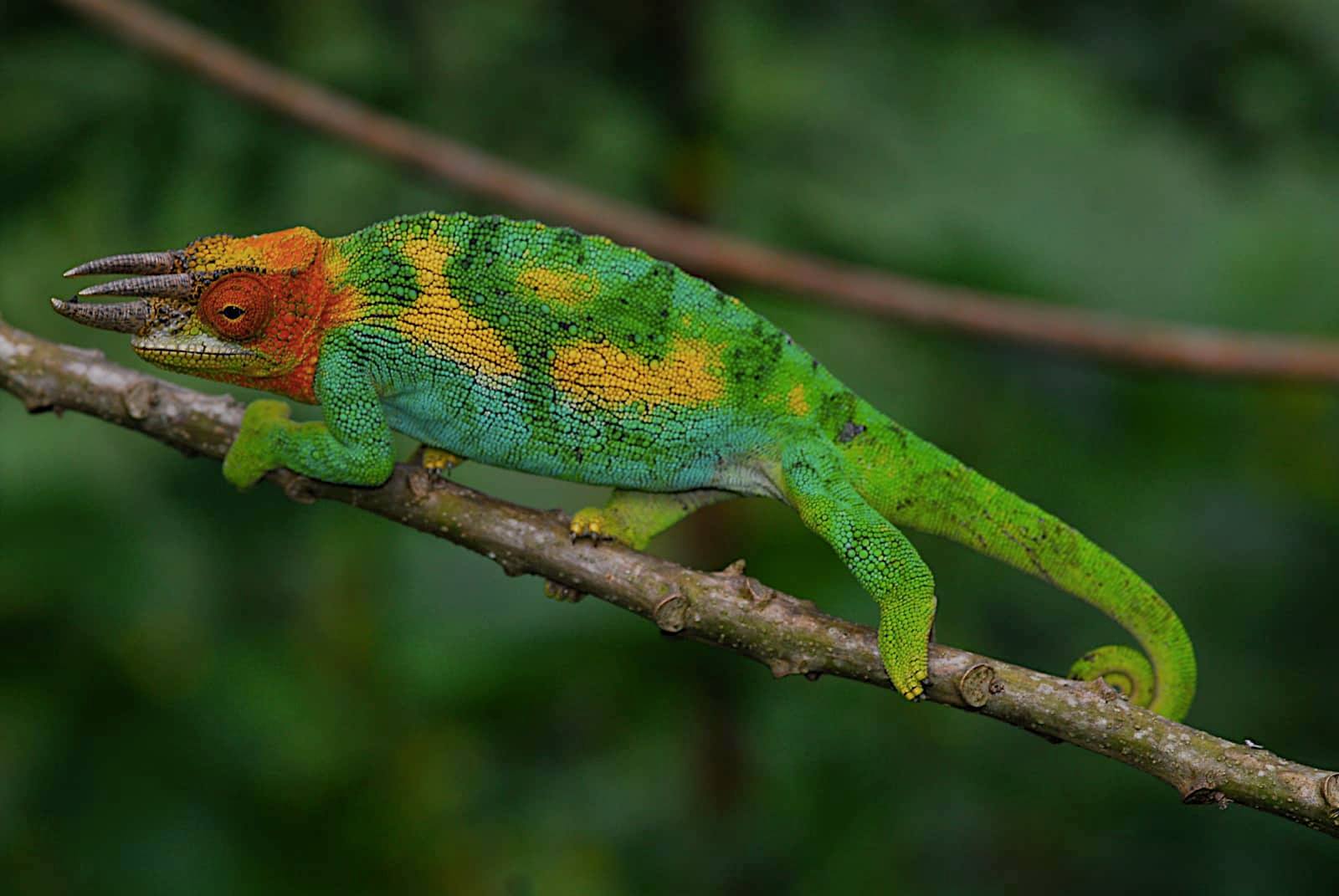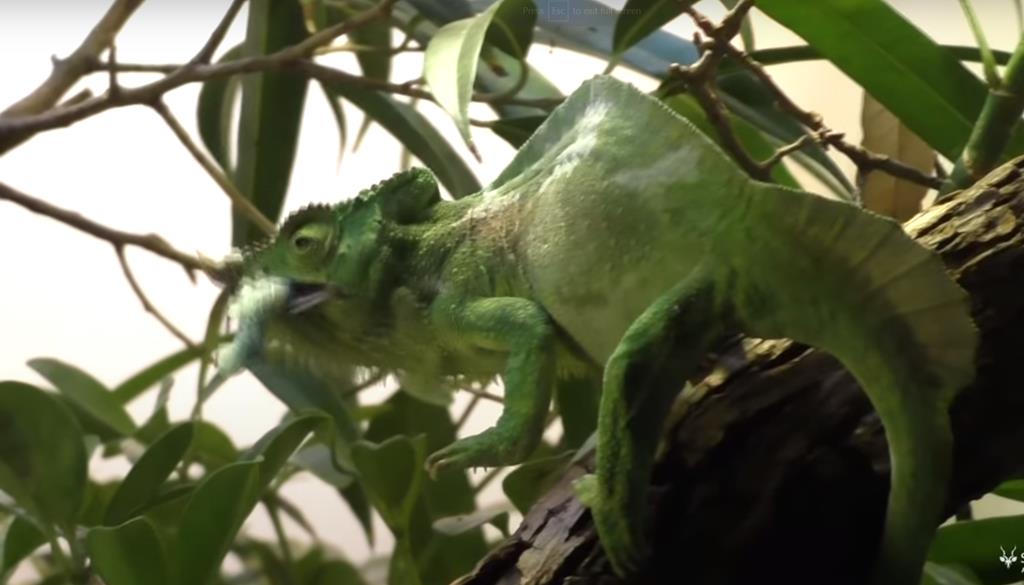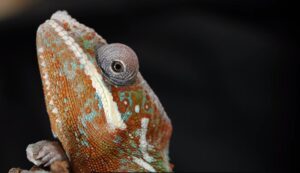The Horned Chameleon is a distinctive species known for the horn-like projections on its head. It inhabits the forests of Tanzania and has remarkable color-changing abilities.
Horned Chameleons are captivating reptiles, with males prominently displaying tri-horn structures that make them instantly recognizable. These solitary creatures thrive in the moist, cool environment of the Tanzanian rainforests. Their expert color-changing provides a critical camouflage against predators, allowing them to blend seamlessly with their surroundings.
Horned Chameleons are also known for their deliberate, slow movements, which reduce noise and disturbance in their leafy habitats. Diet-wise, they feast on a variety of insects, capturing prey with their long, sticky tongues with incredible precision. Their unique appearance and fascinating behaviors make Horned Chameleons a subject of interest among herpetologists and reptile enthusiasts worldwide.
Introduction To The Horned Chameleon

Welcome to the mystical world of horned chameleons. These creatures are like gems of the reptile kingdom. Their unique features and behaviors delight reptile enthusiasts around the globe. Let’s embark on a journey to discover the wonders of the horned chameleon.
Captivating Features
Horned chameleons, famous for their triangular-shaped horns, are a sight to behold. These horns earn them a comparison to mythical dragons. Below, marvel at the unique features that set them apart:
- Vibrant skin that changes color with mood and environment.
- Zygodactyls feet for a strong grip on branches.
- Turret-like eyes that can move independently.
Their tongues shoot out in a flash to capture prey. It’s a riveting display of natural engineering.
Native Habitats
Horned chameleons grace different parts of our world. Their native habitats include:
| Location | Environment |
|---|---|
| Sub-Saharan Africa | Rainforests, Savannas |
| Madagascar | Tropical jungles |
| Middle East | Arid deserts, Mountainous regions |
These habitats provide the perfect backdrop for horned chameleons to thrive. Conserving these areas is key to preserving their future.

Credit: www.chameleons.info
Decoding The Mystique
The Horned Chameleon grips the imagination with its mythical appearance. Myths weave through its history, as intriguing as its rare sight. Yet, what hides behind its horned silhouette? Let’s unveil the enigma wrapped in its vibrant scales, unmasking truths and explaining how this creature behaves in the wild.
Myths Vs. Facts
Horned Chameleons are steeped in lore. People tell tales of their magical abilities. They sprout horns to protect hidden treasure. Or so the myths say. But science seeks truth, not treasure. Let’s bust some myths and shine a light on the facts.
- Myth: They use their horns in combat like mythical beasts.
- Fact: Horns aid in visual displays and deter predators.
- Myth: Their colors reflect mood and future events.
- Fact: Color changes are for communication and temperature regulation.
Unique Behavior Explained
The Horned Chameleon’s behavior is a dance of adaptation. Their movements seem calculated, almost premeditated. With deliberate steps, they blend into their environment. Their swaying walk mimics leaves in the breeze. This clever act fools hungry eyes.
| Behavior | Purpose |
|---|---|
| Tongue Projection | Snatches prey from afar |
| Horn Display | Intimidates rivals and predators |
| Eye Rotation | 360-degree visual awareness |
Setting Up The Perfect Habitat
The quirky and captivating Horned Chameleon requires a habitat that meets its unique needs. A meticulous setup ensures this exotic creature thrives in a home reminiscent of its natural environment. Below, explore the essentials in crafting the perfect abode for these remarkable reptiles.
Terrarium Requirements
Terrarium size is crucial for Horned Chameleons. Here’s what’s needed:
- Size: At least 24 inches tall to allow climbing.
- Material: Glass for visibility or well-ventilated mesh.
- Decoration: Branches, foliage, and hiding spots mimic the wild.
Ideal Temperature And Humidity
Temperature and humidity are vital for your chameleon’s health.
| Zone | Temperature (F) | Humidity (%) |
|---|---|---|
| Basking Spot | 85-90 | 60-70 |
| Cool Zone | 70-75 | |
| Night | 65-70 |
Maintain these conditions with thermostats, humidifiers, and misting. Providing UVB lighting for 10-12 hours a day is also key for health.

Credit: www.chameleons.info
Feeding Your Horned Chameleon
As a proud owner of a horned chameleon, it is crucial to understand the nuances of feeding these fascinating reptiles. Horned chameleons thrive on a varied diet that mimics their natural food sources. This section will delve into the essentials of feeding your horned chameleon, ensuring a happy and healthy pet.
Dietary Needs
Nourishment for your horned chameleon must include a mixture of insects and plant matter. In the wild, these creatures’ diets consist primarily of:
- Live insects like crickets, mealworms, and waxworms
- Occasionally small vertebrates
- Leafy greens for additional nutrition
Variety is key to a balanced diet; thus, regularly switching between different food items is encouraged.
| Insect Type | Feeding Frequency |
|---|---|
| Crickets | Daily |
| Mealworms | 2-3 times weekly |
| Waxworms | Once weekly |
Supplements And Water
Supplementation is vital for preventing nutritional deficiencies. Calcium and vitamin supplements should be dusted on the chameleon’s food at least twice a week. These aids in bone development and overall health:
- Calcium without Vitamin D3 (daily or every other day)
- Calcium with Vitamin D3 (twice a month)
- Multivitamin powder (once a week)
Proper hydration through misting and dripping systems helps simulate rain, enticing the chameleon to drink. Ensure clean water is available at all times.
Maintaining Health And Happiness
Keeping a Horned Chameleon healthy brings joy to any pet owner. Like all pets, these exotic reptiles thrive with proper care. A key to their well-being involves regular monitoring and a suitable environment. This guide helps identify signs of a flourishing chameleon and alerts you to health issues.
Signs Of A Healthy Chameleon
- Bright, clear eyes that track movement well
- Active tongue with a quick, accurate strike
- Strong grip on branches, showing healthy limbs
- Bright skin coloration indicating good stress levels and health
- Regular eating and shedding habits, critical for growth
Common Illnesses To Watch For
Knowing the signs of illness can save a Horned Chameleon’s life. Early detection is vital. Here are some symptoms to watch:
| Disease | Symptoms |
|---|---|
| Metabolic Bone Disease | Weakness, curved limbs, jaw swelling |
| Respiratory Infections | Mucus around the nose or mouth, labored breathing |
| Parasitic Infections | Weight loss, lethargy, abnormal droppings |
| Skin Infections | Discolored scales, sores, skin flaking beyond regular shedding |
Consult a reptile veterinarian if these symptoms appear. Regular vet check-ups and a well-maintained habitat reduce these risks.
Interaction And Social Needs
The Horned Chameleon is a distinctive reptile, celebrated for its striking appearance and unique behavior. Understanding their interaction and social needs is pivotal for a thriving pet. This section delves into managing your Horned Chameleon, ensuring their comfort, and the dynamics of chameleon cohabitation.
Handling Your Pet
Handling Horned Chameleons requires patience and gentleness. Their solitary nature means less desire for human contact. Follow these tips for a happy, stress-free pet:
- Limited handling: Keep it to a minimum to avoid stress.
- Gentle approach: Move slowly and let them come to you.
- Support from beneath: Offer a hand or finger for them to step onto.
Remember that regular, mindful interaction can build trust over time, making handling smoother for both you and your chameleon.
Chameleons And Cohabitation
Cohabiting chameleons can be tricky. Here’s what you need to know:
| Age | Gender | Number | Enclosure Size |
|---|---|---|---|
| Young | Any | 1-2 | Medium |
| Adult | Female | 1 | Large |
| Adult | Male | 1 | Extra Large |
Adult males are territorial and need separate habitats. Females may cohabitate, but monitor closely for stress. Juveniles can live together temporarily. Space, visual barriers, and multiple food sources prevent competition and stress.
Breeding And Lifecycle
The Horned Chameleon has a captivating breeding cycle. Understanding the unique stages can deepen our appreciation of these exotic creatures.
Successful Breeding Practices
To breed Horned Chameleons successfully, a few key conditions must be met. Temperature and humidity control are crucial, as these reptiles thrive in specific climates. Breeders should provide a stress-free environment with ample greenery and branches for climbing. Appropriate multivitamin supplements are essential for the chameleons’ health and fertility. Most importantly, males and females need to be carefully introduced to each other to ensure they are compatible for mating.
- Maintain optimal habitat climate
- Create a naturalistic and peaceful setting
- Include rich diets with vitamins
- Monitor male and female interactions closely
Egg Laying And Hatching
After successful mating, the female Horned Chameleon will lay eggs. This typically occurs within a burrow or a secluded spot in the enclosure. The eggs must be carefully excavated and transferred to an incubator with controlled conditions for optimal development. A consistent temperature is necessary to ensure the eggs develop properly.
| Egg Laying | Incubation Period | Hatching |
|---|---|---|
| Female chameleons lay 5-40 eggs | Approximately 6-9 months | Hatchlings emerge fully formed |
It’s important to note that the hatchling survival rate is influenced by the quality of care. Once hatched, young chameleons should be kept in separate enclosures to prevent stress and competition for resources. They require small prey and gentle handling, if at all, to grow healthily into adults.
- Transfer eggs to incubator with care
- Monitor temperature and humidity daily
- Observe for signs of hatching
- Separate hatchlings into individual enclosures
Conservation And Ethical Concerns
The horned chameleon, with its unique horns and vibrant colors, sparks great interest. Yet, these fascinating creatures face threats leading to their decline in the wild. Let’s dive into the critical discussion about their conservation and ethical considerations.
Impact Of Captivity
Chameleons do not thrive in captivity. Capturing chameleons from the wild can harm their populations. It also disrupts ecosystems.
Horned chameleons suffer in small enclosures. They need space to move and hunt like in their natural habitats. Survival rates drop drastically outside the wild.
- Stress from handling and improper care
- Potential for spreading diseases
- Illegal pet trade harms chameleon numbers
Supporting Conservation Efforts
Saving horned chameleons needs action. Here’s how to help:
- Educate others about chameleons and their habitats.
- Support organizations that protect not just chameleons, but whole ecosystems.
- Adopt ethically. Choose captive-bred chameleons from reputable sources.
| Action | Impact |
|---|---|
| Donations | Funds conservation projects. |
| Volunteering | Assists in habitat restoration. |
| Eco-tourism | Promotes sustainable income for local communities. |
Frequently Asked Questions For Horned Chameleon
What Is A Horned Chameleon?
The Horned Chameleon, also called the Jackson’s Chameleon, is a reptile species known for the horn-like projections on its head. Originating from East Africa, this chameleon is a popular exotic pet due to its distinctive appearance and color-changing abilities.
Where Do Horned Chameleons Live?
Horned Chameleons are native to the humid, cooler regions of East Africa. They thrive in forested areas and are arboreal, spending most of their time in trees. Their adaptability also allows them to live in captivity, where they can be commonly found as pets.
What Do Horned Chameleons Eat?
Horned chameleons, such as Jackson’s chameleon (Trioceros jacksonii) or other species with horn-like projections on their heads, are primarily insectivores. Their diet mainly consists of various insects, including crickets, flies, roaches, grasshoppers, and worms. In the wild, they may also consume small lizards or other invertebrates.
In captivity, horned chameleons can be fed a variety of appropriately sized live insects, gut-loaded and dusted with calcium and vitamin supplements to ensure they receive proper nutrition. It’s essential to provide a balanced diet to maintain their health and well-being. Additionally, offering occasional treats like fruit flies or waxworms can add variety to their diet, but these should be given in moderation.
How Do Horned Chameleons Change Color?
Horned Chameleons change color through specialized cells called chromatophores in their skin. These cells expand or contract to mix colors like pigments on a palette, allowing the chameleon to blend with its environment or communicate.
How big are the four horned chameleons?
What do four horned chameleons eat?
Conclusion
Exploring the horned chameleon’s captivating realm reveals a creature as mysterious as it is magnificent. Their diverse habits and unique appearance underscore nature’s complexity. For enthusiasts and conservationists alike, ensuring these reptiles continue to thrive is paramount. Let’s cherish and protect the horned chameleon’s extraordinary place in our world’s tapestry.

